George Haas has written this summary of the August 3, 2021 demonstration by Eric Schrader.
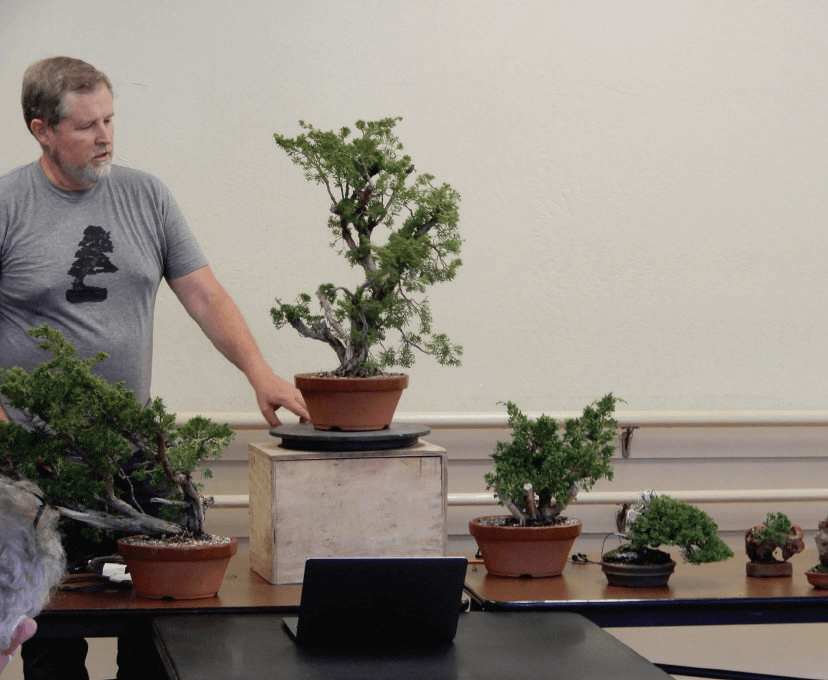
The change from Autumn into Winter is a truly profound one in most of the world of nature, and we all know it by heart: The Harvest moon, golden Autumn afternoons, crisp chilly evenings with sweaters and hats, the first frost and the unexpected ice on the water in the morning. Here in the Mediterranean and desert-like microclimates that makes up so much of California, we only know about all that stuff because we read about it, maybe even saw pictures. It might as well be just a collection of stories and rumors calculated to make us glad, we live here.

As bonsai artists and enthusiasts, our gardens have a lot of advantages: No, or very few, freezes, and if we get a cold snap it’s almost always a brief unpleasantness, not a weeks-long, life threatening ordeal. No frozen roots, so a little bit of growth usually continues in spite of weaker sun and shorter days. But the changes are there to some degree, and are useful. Trees need rest too, to get ready for the Roller Derby riot of Spring. There are lots of things to do in the garden to help them along.
Take the wisteria and other tropical or semi-tropical trees out of the water bath where they spend their Summers. They now become a watering problem, needing a truly moist winter without being squishy wet.
Take the remaining leaves from trees which have yellowed or dropped seventy or eighty percent of their leaves, and do some light trimming or moderate wiring and set them all together in a dimmer part of the garden because they no longer need the lion’s share of the sunlight that the junipers and pines and other conifers will require. These bare trees now become a watering problem, needing to be kept from ever drying out but never wet.
In November and into December, evaluate the black and red pines for health and vigor to get a sense of how the summer buds that were selected have done and a little wiring might be helpful even if it’s just to provide a bit more light into the interior space of the tree and its back buds. White pines, mugo pines, and all other high-mountain types can be worked and cut and shaped and wired. But all the pines now become a watering problem, because they and the junipers and the rest of the conifers need to sit in the full sun all winter to take advantage of that ability, they have to remain slowly active even when it’s cold.
See a pattern here? Water is always an issue. Water is a harder problem to take care of in colder weather and the clues you need are harder to find and harder to read. Be careful, be observant, and be systematic. If there’s a question or an issue, don’t wait. Contact someone in a bonsai club who has healthy trees under their care, and get help.
Some growers in warmer climates fertilize all year, usually with low-number fertilizers like Bloom 5-5-5 or Gro Power 5-3-1. Others switch to 0-10-10 to keep the nitrogen out of the soil during dormancy. In every case the most successful growth seems to be with consistency, neither feast or famine, always feeding regularly and on time.
Keep an eye on the weather. In case of a cold snap, place pots under eaves, under benches and hedges and big trees, and wait for the warm up to put them in the sun again. Most plants can stand a few hours of freeze, and a few plants, like most azaleas, seem to like a bit of frost now and then, but why take a chance? And guess what? Extreme and/or prolonged cold becomes a water problem. Moist but not wet can be hard to accomplish in really cold weather.
Clean off all the benches and all the ground around to prevent overwintering pests. Scratch off the top half inch or so of soil and replace it with fresh soil for the same reason, and also to increase immediate water permeability to help with the (you know this by now) Water Problem.
Don’t neglect to do dormant spraying at the end of November, December and January. Use lime sulfur, dormant horticultural oil sprays and/or copper based dormant sprays like Lily Miller Microcop fungicide. Always follow label instructions regarding dilution rates and application carefully. Cover the soils so sprays and drips don’t get into the pots.
Go out in the garden some dark night with a flashlight. Everything looks so different; it might bring a new perspective. Go out on a bright moonlit night without a flashlight and just be with these living beings that depend on your faithful well-meaning attention for their daily existence. Go out in the dawn to experience a new day’s beginning with your partners in this ancient, compelling art, and you may find that the notes of hope heard there, however faintly, can become a chord of harmony and gratitude in your heart.
– Chris Ross
Autumn Haiku
Autumn passes through.
Summer burns in the treetops
For a few more days.
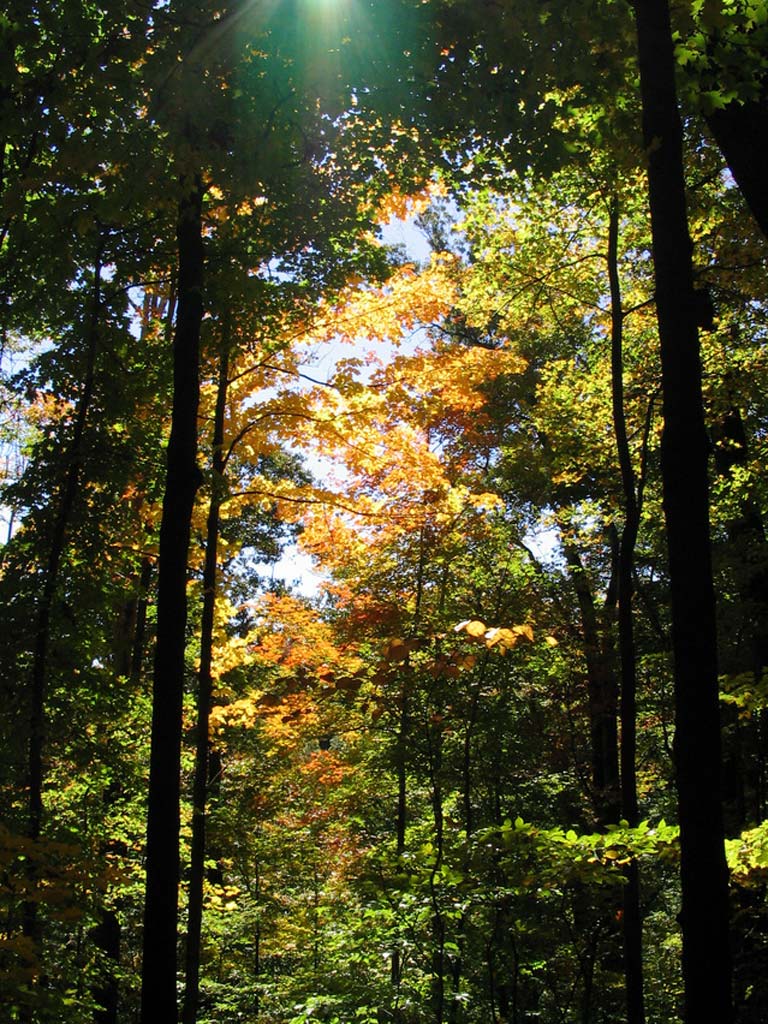
In March of 2020, with pandemic-related uncertainty at its highest and information at its lowest, the Marin Bonsai Club had what would be its last meeting before the official stay-at-home order. Our last guest of honor: President of the Redwood Empire Bonsai Society and owner of Mendocino Coast Bonsai, Bob Shimon. He came to talk to us about redwoods and demonstrate some work on a relatively young sample of the species, which was raffled off at the end of the night.
After telling us a little bit about himself and his business in Port Arena, Bob introduced the trees he brought for illustration purposes and the subject of the evening, a nice healthy pre-bonsai redwood. It had been a much larger, but still relatively juvenile tree, and it was collected via backhoe from a private yard that was being completely renovated a little over a year prior to the present evening. The large main trunk was removed at the time of collection to favor the smaller saplings at its base. Because he has more trees as part of his business than anyone can remember in detail, Bob was reconstructing the recent history of the demo tree as he worked. But he quickly knew this tree had been collected relatively recently based on its soil and the type of pot it he had it in, and then began to recognize it further as his work became more involved.
Bob always uses a sandy mix and an oversized container for newly collected trees, to encourage lots of fine feeder roots. The presence of both is what tipped him off that this tree had been in his collection for less than two years. He removed the tree from its pot, knocked away some of the soil, and confirmed that there were plenty of new roots on the tree now, forming a mass much wider than the base of the trunk. Bob pointed out that most of those roots grew since the tree was collected. Much like olive trees, redwoods can lose a very high proportion of their roots and still recover, greatly simplifying the collection process and vastly increasing the chances for success.
By the way, for those unfamiliar with the term, “collect” in this context is used to indicate the bonsai-specific act of gathering a specimen from a wild (with proper permits) or privately landscaped area. In other words, it’s the process of turning something that was once growing mostly or entirely on its own, and in the ground, into a potted tree ready to be transformed slowly into bonsai, a stage known as pre-bonsai. Aside from the removal of oversized parts, like the large original trunk, collected trees are left virtually untouched and extremely pampered long enough for them to reestablish a healthy root system.
While on the topic of the demo tree’s root ball, Bob said that the eventual winner of the demo tree should repot it at their earliest convenience, because it’s ready to move on from the sandy root-establishment medium to true bonsai soil. He said that redwood trees can be given pure Akadama (the baked clay soil pellets that are the cornerstone of good moisture-retaining bonsai soil), but can be happy in a variety of soils, as long as they contain at least half Akadama. They’re moisture loving trees after all. He went on to say that the demo tree winner should completely clean the roots of all current soil, and cut the major roots about halfway back. He also pointed out that the demo tree might benefit from some tilt when it’s repotted. And a final note on the topic for all of us: avoid repotting redwoods when it’s hot out!
Once he was finished examining the demo tree’s roots, Bob focused on the base of the trunk next, cutting away the long runner/sucker branches that had sprouted there in the spring. He cut those away for two reasons: because they’ll sap energy from the rest of the tree otherwise, and because most of the tree’s inherent interest resided in the base of the trunk and those stringy, unwanted branches were blocking it from view. He said that this area of the tree is interesting enough that the winner of the tree shouldn’t bother carving on it, with the exception of the stump where the bulk of the original tree was sawed off. That needed some jiining to make it look natural instead of straight cut. He asked for some audience participation to help strip outer layers of the stump, but said that he would just get it started and the eventual winner would be able to add their own touch to it. He also pointed out that in most cases lime sulphur is not needed for redwoods, because they resist rot. Use it if you please, but the whitening it causes is also not natural-looking on redwoods. If you insist on using lime sulphur, consider coloring it to tone down the bright white.
With the jiining on the stump far enough along, Bob garnered audience opinion to help choose the front and then the apex of the tree. As soon as the preferred apex was decided upon, Bob promptly lopped off the strongest alternate. He then proceeded to wire the branches to give them a bit of an umbrella shape, while giving some more general information about redwoods.
Bob says one of the most frequent questions he gets is how to fix legginess in redwoods, that annoying tendency some trees have to look like skeletons of proper bonsai. The first part of his answer was that redwood bonsai are notoriously high maintenance. You need to trim them successively over time for optimum results. Secondly, because they want to grow tall and skinny, and favor their growth tips, they will gladly let lower and interior branches die to distribute more energy to the ends of their upper branches. Therefore, the bonsai artist’s job is to develop fuller branches that the tree is willing to keep alive, and that satisfy bonsai aesthetics, without trimming in such a way as to force the tree to give up on one or more branches entirely.
The first thing to bear in mind when trimming leggy branches on a redwood is that you will have to work them back gradually. Redwoods will bud from almost anywhere, and every leaf-like collection of needles will eventually become a branch and can itself be branched, but one wrong cut can be catastrophic. In particular, if you don’t leave some pre-existing lateral growth on a branch that you’re shortening, the whole branch will almost certainly die back. Your only consolation in that predicament will be the exceptionally high likelihood that new shoots will pop out of the origin point of the now-dead branch.
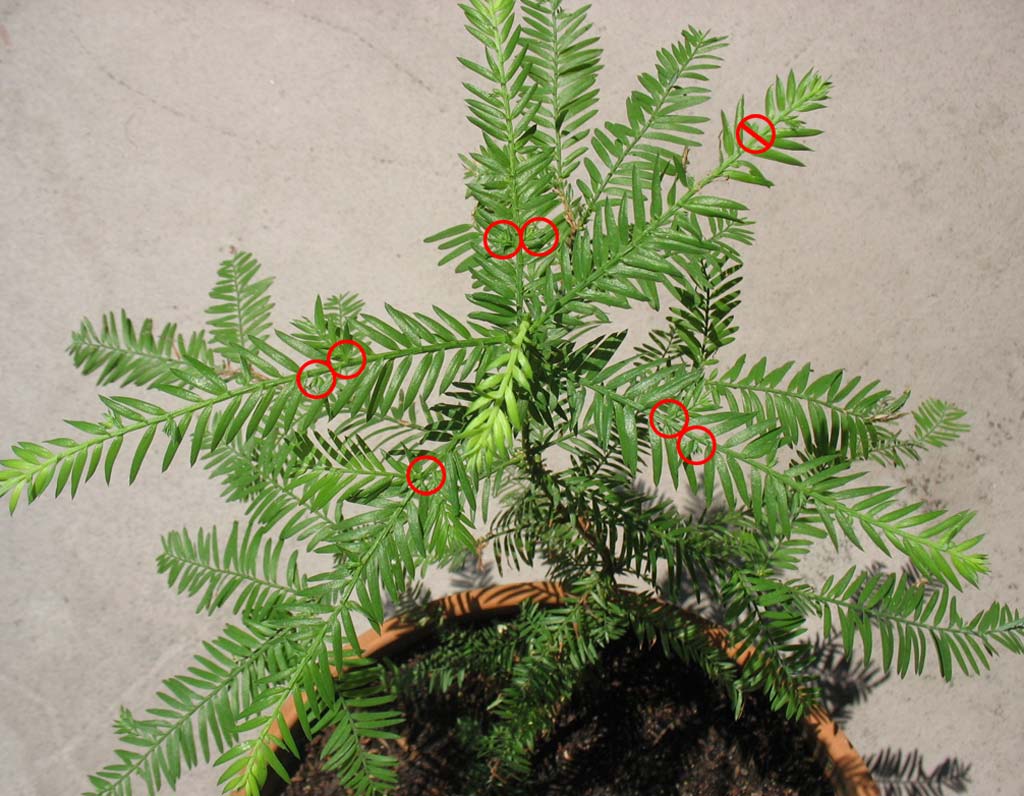
The solution is to check the branch for adventitious buds or other lateral growth and make sure your cut is farther away from the trunk to preserve that growth, along with the tree’s interest in keeping the branch alive. The photo here, of a very young sample tree that was not part of Bob Shimon’s demo, has red circles to indicate nice close-in lateral growth points that would allow the branches to survive if cuts were made just beyond them. Trimming the upper branches in this way on this particular tree would redirect energy to help bulk up the lower branches and prevent the tree from letting them die away, without disturbing the apex.
Note the branch in the photo with no buds until almost at the tip, with the slash through the circle. Only the very tip of this branch can be removed at this time. In cases like this, where the only lateral growth is not as far in toward the trunk or main branch as you would ultimately like, that’s where the multiple trims over time become important. After you make the first cut, more buds are likely to appear along the length of the branch, allowing you to cut closer-in next time. Bob gave one final tip for trimming redwoods: back-budding is most likely to occur if branch tips are pinched when they’re young and tender.
Bob gave some general redwood care advice as he finished wiring the demo tree. He recommends a balanced fertilizer, with no number over 10, for the growing season. He switches to a 0-10-10 for the winter, since redwoods don’t grow much during the winter. His favorite form of fertilizer is granular. It’s also important to know that redwoods are acid-loving trees. Finally, redwoods can take heat, but they’ll burn under direct sun, so partially sunny or shaded areas are best for them.
After finishing the demo tree, Bob started giving tips for member trees that were brought in. He took one look at the pine tree Diane Matzen had just acquired at the previous meeting and got a few gasps from the audience as he lopped a huge extraneous piece off of it. Then he looked at a tree of Peter Miller’s that had lots of branches dying back, and said that it might have been cut back too early. After looking at a couple more member trees, Bob drew the ticket for the raffle and Chris Ross won the demo tree. Chris promised to bring the tree back so we can see how it develops and learn from what further things he does to it.
– David Eichhorn
Photos courtesy of George Haas, Sharon Bone and David Eichhorn
Jonas Dupuich, host of the popular blog “Bonsai Tonight” (www.bonsaitonight.com), and now author of the book “The Little Book of Bonsai,” joined us in January to give us some guidelines on how to admire and display shohin bonsai, which are generally considered any bonsai ten inches or shorter. The maximum height given by the precise Japanese definition is 25 cm.
After giving us a sneak preview of his new book, “The Little Book of Bonsai,” and generating some more buzz regarding the then-upcoming BABA show, Jonas fired up his projector and started us off with some slides from the 2020 Gafu Ten Shohin Exhibition in Japan. He wanted to show us some high-end, very traditional shohin display examples before moving on to coaching us in assembling our own displays, as a group, from the many trees and stands he and club members had gathered that night.
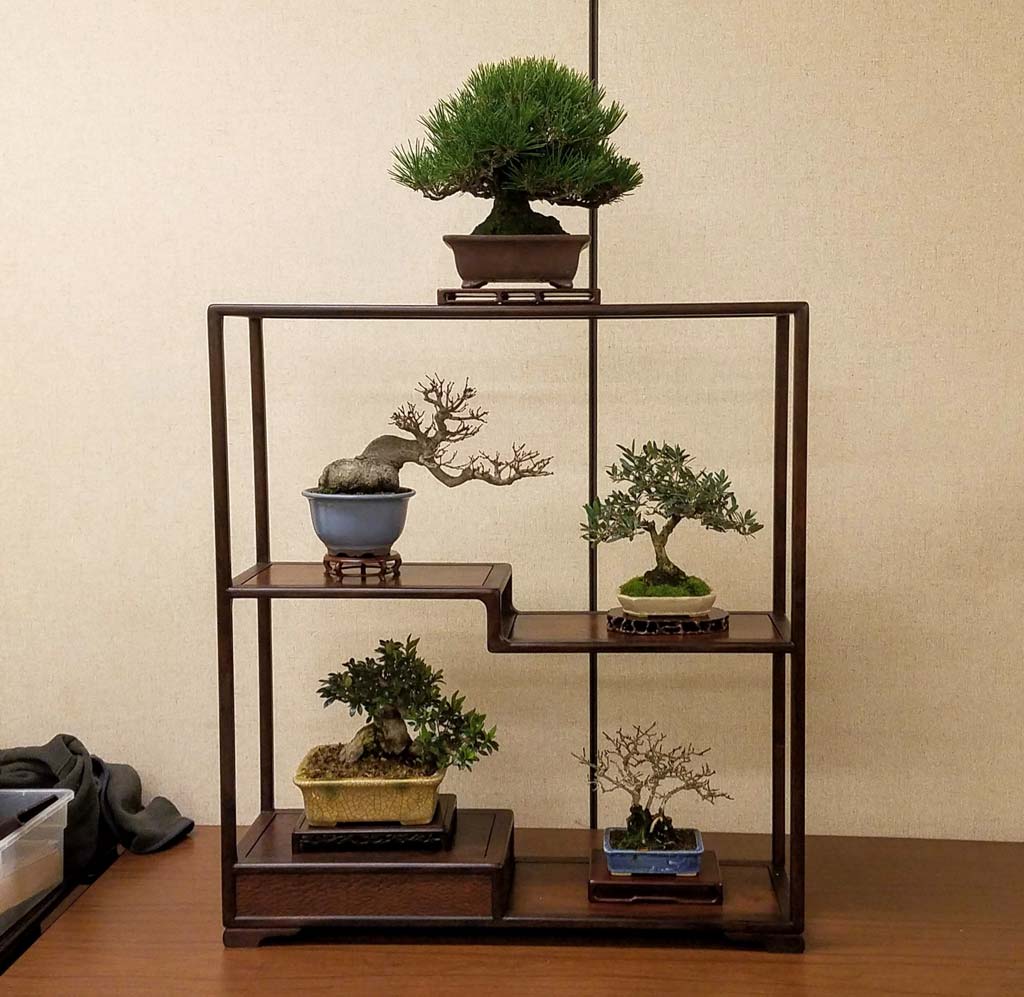
At some point after the first few slides, as part of a discussion of how difficult it is to get truly dramatic trees at such small scales, Jonas turned to one of the trees he brought, a 26-year-old, picture-perfect black pine with a nice fat trunk, though he admitted it’s not quite small enough to call a shohin. He said it’s one of the oldest pines he’s created in his decades of working with them, but that if he did it now, he could do the same thing in 12 years.
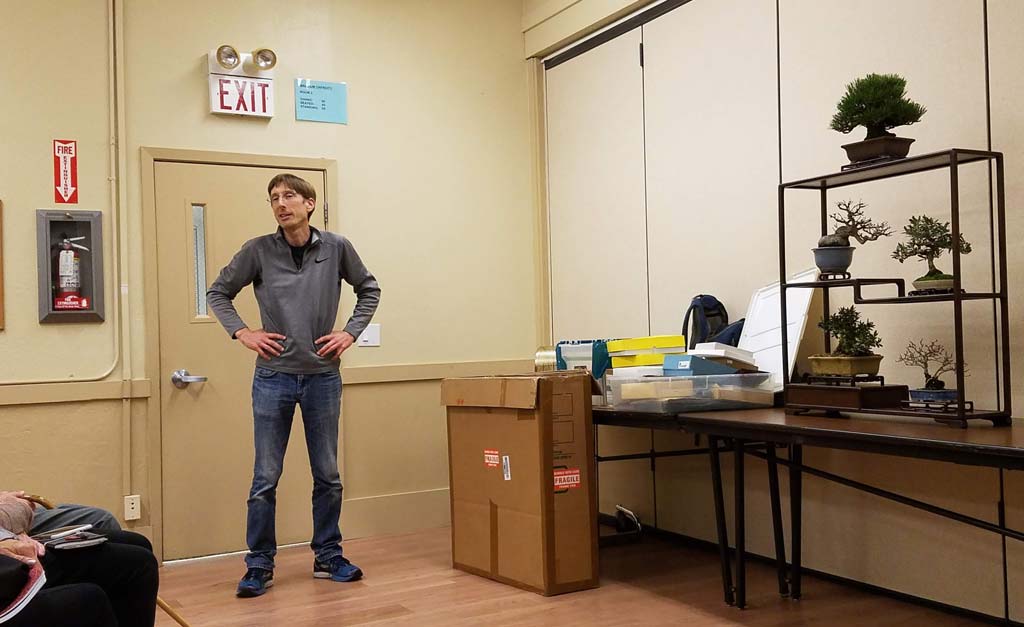
Starting with a simple display from the Gafu Ten exhibition, with a tree on each side, a scroll in the middle, and an accent plant, Jonas explained the first of the three most important features in any good shohin display: contrast. The other important features are directionality and balance. Jonas pointed out how the two trees in the simple display contrasted with one another, but were balanced by the other elements. Directionality is somewhat crude in simpler displays, but Jonas went on to show many more examples illustrating that feature. The most basic directionality rule the slides revealed is that trees on the right side of a display need to have any movement implied by their limbs pointing predominantly to the left, and conversely for trees on the left side, so as to keep the viewer’s eyes moving back toward center.
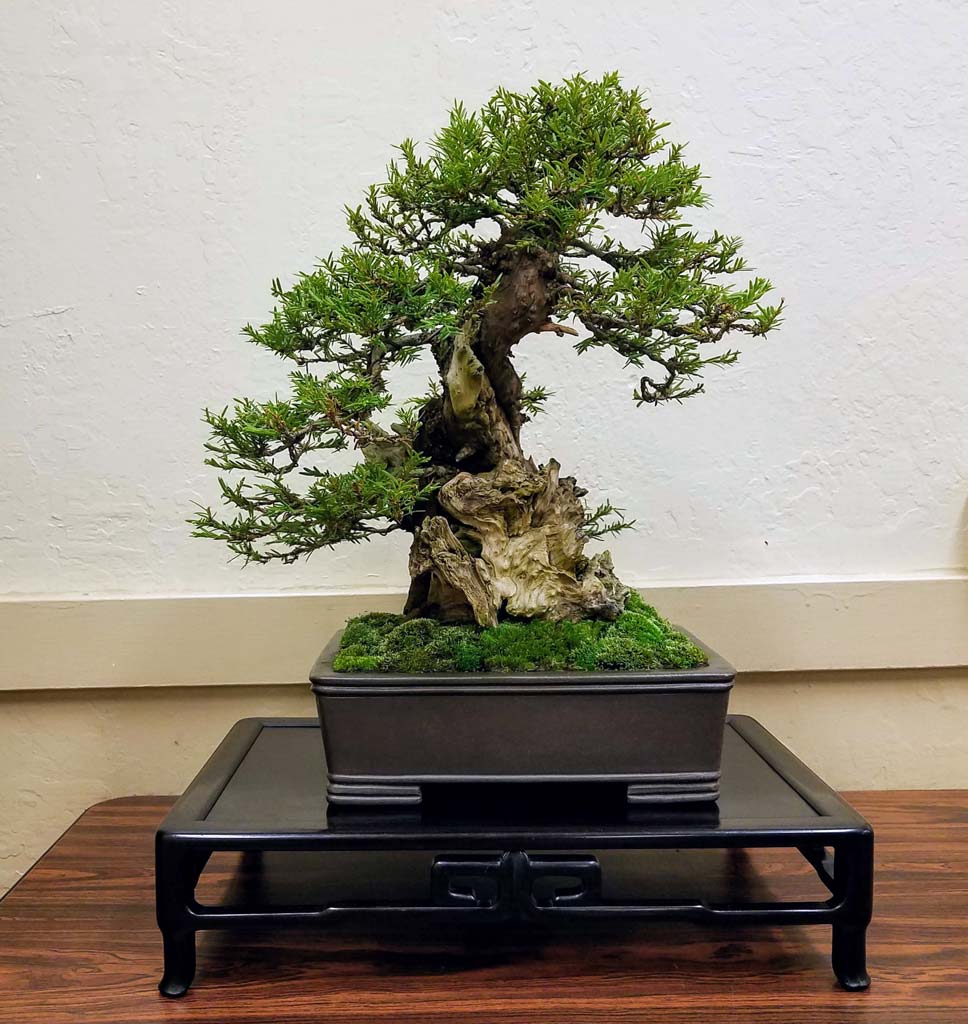
Before proceeding to more slides illustrating further shohin conventions, Jonas showed a slide of a bunjin-style (also called literati) camellia. Clearly more than ten inches tall, the camellia demonstrated that there are exceptions to all category conventions, especially when it comes to bunjin, a style that intentionally bucks traditions to create extreme looks.
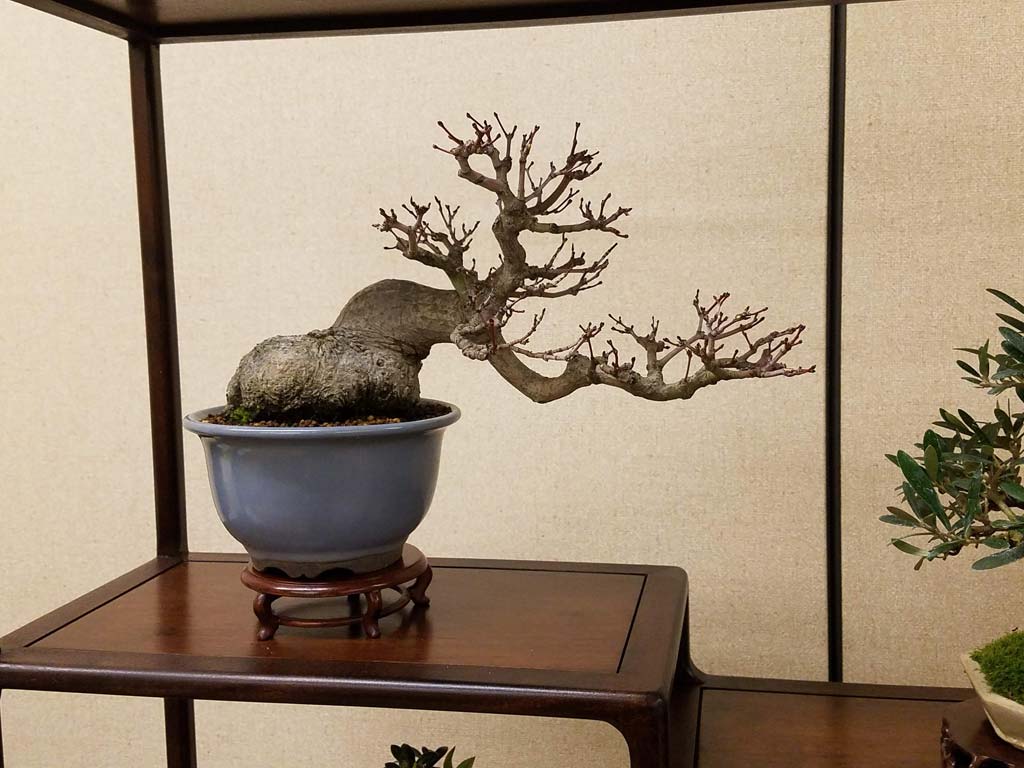
At most shohin shows, but particularly in Japan, there are fairly strict conventions around the sizes of the boxes that contain the little trees. There tend to be three sizes from which the artists must choose, and alternate sizes have been frowned upon long enough that nobody strays from the assigned box sizes. This type of convention no doubt arose because a more freestyle approach would add a randomness that would destroy the neat, curated feel of the exhibit.
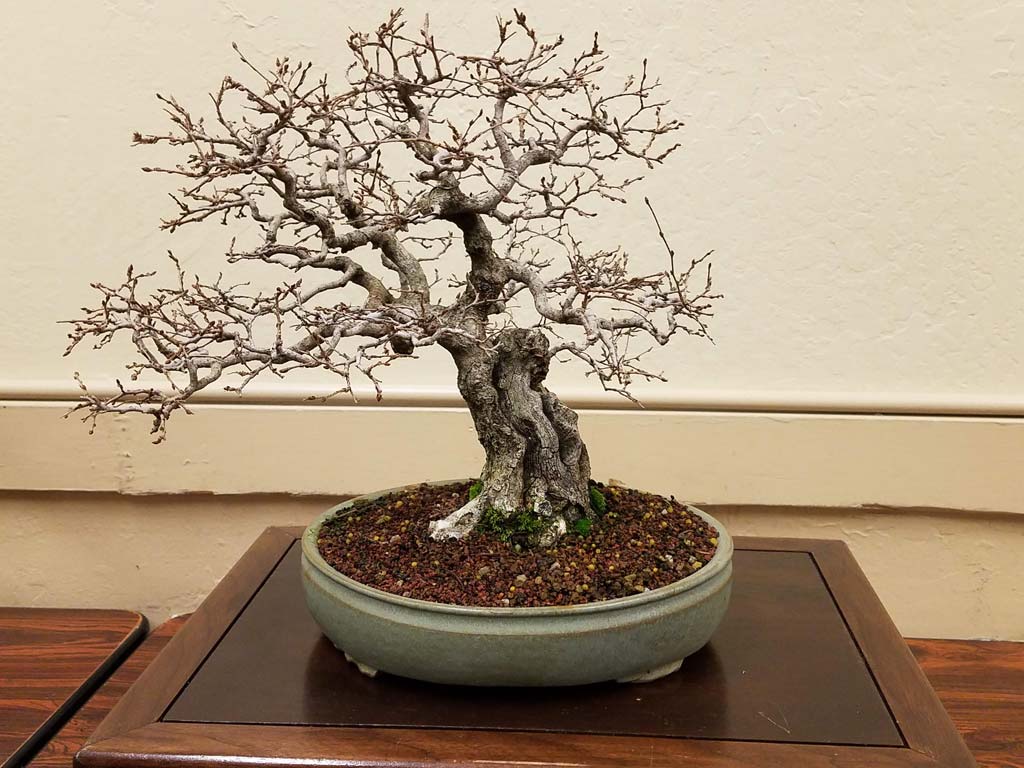
Another shohin display convention dictates that the topmost tree should be a black pine. This is to suggest a high mountain area, even though black pines are, ironically, coastal trees. The full list of conventions is too long for Jonas to have likely covered them all, let alone listing them all here, but among them are pot color and glazed-not-glazed combination standards, shared-height preventions (basically, nothing should be at the same height as anything else), and a general thematic guideline that the various trees should represent the different seasons.

Though Jonas and some of our own club members clearly enjoy, and excel at, creating shohin masterpieces, it’s certainly one of the most difficult forms of bonsai, and anyone wanting to reach the level of displaying at a show on their own needs to have a lot of small trees and display stands. But Jonas was there to encourage anyone wanting to try it out, and to remind us that we have a club to support our courage. Best of all, Jonas came prepared, with the help of some of our club members, to give a taste of what it’s like to assemble a shohin display without having to collect all the necessary paraphernalia. Using the great assortment of trees, pots, and stands gathered together for the evening, Jonas took display combination suggestions from the audience for the rest of the night.
Jonas also brought a small pine with him to raffle off at the end of the night. Chris Ross won the tree and then promptly sold it to one of our newer members, Diane Matzen. Congratulations to you both!
– David Eichhorn